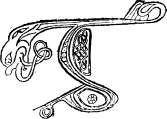
SECTION III.
Distraint by Fasting

ENERALLY a person before proceeding to distrain was bound to give certain notices. "A notice of five clays is to be served on a debtor of the inferior grade, and then distress is to be taken from him." "A notice of ten days upon the debtor of chieftain grade." If the defendant was a chieftain, a flaith, a brehon, a bard, or a bishop, the plaintiff was obliged to fast upon him in addition. "Notice precedes every distress in the case of the inferior grades, except it be by persons of distinction or upon persons of distinction; fasting precedes distress in their case." The Troscead, or fasting upon one, consisted in going to his house and waiting at his door a certain time without food. The text says, "He who refuses to cede what should be accorded to fasting, the judgment on him according to the Feini is that he pay double the thing for which he was fasted upon." This was a strong measure. And the commentary says, "If the plaintiff has fasted without receiving a pledge, he gets double the debt and double food." Again the text says, "He who fasts notwithstanding the offer of what should be accorded to him forfeits his legal right according to the decision of the Feini." Clearly the law did not suffer the mode of distress by fasting to be trifled with in any way. If the plaintiff, having duly fasted, did not within a certain time receive the satisfaction of his claim, or a pledge therefor, he forthwith distrained the goods as in the case of an ordinary defendant, and distrained double the amount that would have satisfied him in the first instance. Sir Henry Maine thought that fasting was regarded with a superstitious awe. I rather think the law, without superstition at all, was calculated to inspire a good deal of awe, and that the distinguished defendant, if he possibly could, paid the debt or gave a pledge in order to get the faster, as a dangerous nuisance, away from his door.
Distress by way of fasting, now so strange to us because so long obsolete, was clearly designed in the interests of honesty and of the poor as against the mighty. How or why it assumed this particular form is not known, and shall probably never be known. It was not peculiar to Ireland, however.
A system precisely similar has existed in India from time immemorial, and exists in some parts of that country at the present day. It is called "sitting dhurna." There are also other points of resemblance between the native laws of India and the Irish laws. India and Ireland are too far apart in space, time, and historical connection for these resemblances to be more than coincidences due to similarity of occasion, or to some common cause acting on the minds of men, or to chance.

